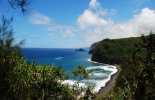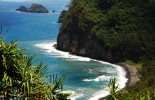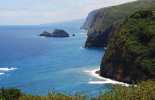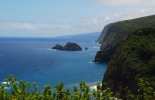11-11-2024
Pololu Valley Overlook
Located within the Kohala Region on Big Island
This article may contain affiliate links. We earn a small commission at no extra cost to you. Mahalo!
Pololu Valley
Kohala Coast Overlook
As you pass the 28 mile marker on Highway 270 past Hawi, the coast will open up and you will suddenly be treated to a breathtaking view of the lovely Pololu Valley.
On a sunny day, you will see the vibrant blue and green ocean crashing into the rugged sea cliffs and the deep green carpet of vegetation lining the sides of the valley. A short walk to the lookout reveals the many folds and creases of the inner part of the valley which drop into a rich, green floor. Lines of ironwood trees divide the lush valley from the grainy black sand beach that meets the ocean.
Early morning is the best time to visit, when you'll have a chance of snagging a parking space in the small lot. Pololu is the end of a string of seven major valleys carved into the northern Kohala Coast of the Big Island which ends with Waipio Valley. This now uninhabited valley was once used to grow taro. The root of the taro plant is pounded down and mixed with water to create a purple paste called poi, a staple of the traditional Hawaiian diet.
Pololu valley is located at the end of Highway 270 in North Kohala. On your drive up Highway 270, be sure to stop for a look-see in the quaint town of Hawi. The highway ends at the picturesque lookout for this valley. At the top you can look down on Pololu valley and a beautiful black sand beach (Pololu Valley Beach). If you are in for a day of adventure you can hike down into the valley on a long zigzagging dirt path called Awini Trail. The valley is fed by a meandering stream. Once in the valley, you can look back at the spectacular views and possibly see some waterfalls.
We recommend you take the 25-minute hike to the bottom of the valley and check out the wonderful scenery and black sand beach. Bring a picnic to enjoy at the bottom of the valley. Wear comfortable shoes and don't forget to take lots of pictures! You can also hike beyond beyond Pololu Valley and up onto the accompanying ridge by continuing along the Awini Trail at the opposite end of the beach. Unfortunately, the trail that hiked down into the next valley, Honokane Nui, was destroyed in the October 2006 earthquake.
Pololu Valley Overlook Reviews
Guidereview:
A (based on 582 visitor reviews)Geolocation Data
Geographic Coordinates
Latitude: 20.20374762
Longitude: -155.7327903
Hawaii Safety Information
Pololu Valley Overlook Photo Gallery





Recommended Tours Nearby
Affiliate Disclosure: We may earn commissions from some travel partners (like Amazon or Expedia) which helps us maintain this site. These links are at no extra cost to you and don't impact our honest & unbiased recommendations. Remove all the ads →








